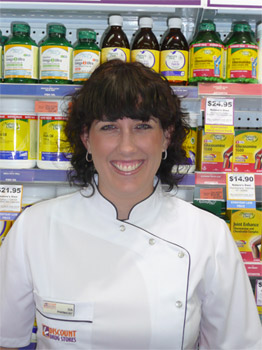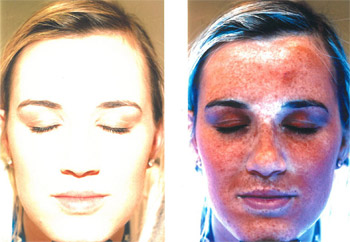Casey Clark Discount Drug Stores Sun and UV Awareness Clinic Interview

Casey Clark Discount Drug Stores Sun and UV Awareness Clinic Interview
In a national first, pharmacy brand Discount Drug Stores is launching coordinated sun & UV awareness clinics across more than 100 of its stores to reveal to customers how much UV damage has been done to their skin, and to help prevent them from causing further damage.
Australia has the highest rate of skin cancer in the world, with approximately two in three Australians expected to be diagnosed with skin cancer before the age of 70.
Discount Drug Stores' national sun & UV awareness campaign aims to combat these high statistics by generating greater community awareness of the risks and consequences of UV damage.
The community pharmacy brand's Professional Services Manager, Casey Clark said that with Australians four times more likely to develop skin cancer than any other cancer, it's absolutely vital people know about the dangers of UV exposure and how to prevent it.
'Australia has such a sun-loving, outdoor lifestyle, but we also have a shockingly high prevalence of skin cancers," she said. 'These clinics will make people more aware by showing them just how little UV exposure it takes to do serious damage."
Despite skin cancer killing more than 2,000 Australians every year, Ms Clark continues stating that many customers are surprised to learn that it only takes as little as five sunburns to double their risk.
'Many people think that a couple of sunburns won't do any serious harm but this is absolutely not the case," she said. 'Not only are they at greater risk of skin cancer but they are also causing premature ageing and sun spots which, while fade, may never go away completely."
The clinics will include a 15 minute consultation with a nurse who will take a photo of the customer's face with a double-exposure camera to reveal how much UV damage has been done to their skin.
The customer is then informed of their results and risks as well as about harmful effects of the sun, including what ultraviolet (UV) rays are, the UV index, and how UV rays damage the skin.
In a bid to ensure customers are protected as best as possible against further UV damage, Discount Drug Stores will also give away a wallet sized UV level tester card so that they can monitor their risk of exposure and damage wherever they are.
'We want to ensure that Australians can enjoy our climate without risking serious UV damage," explained Ms Clark.
'So in addition to assessing the condition of their skin and their risks, we're also providing them with an information booklet, a UV level tester card and a sample of SPF50+ Actinica Sunscreen."
Experts estimate that there will be almost one million skin cancer treatments a year by 2015. Discount Drug Stores hopes that through arming Australians with fundamental knowledge and resources it will combat this shocking statistic.
Interview with Casey Clark
Question: What inspired the sun and UV awareness clinics at Discount Drug Stores?
We also know that sun damage can cause premature ageing, and nobody wants that!
Question: What were your hopes for the sun and UV awareness clinics?
Casey Clark: Our main hope was to help at least some of our customers understand the importance of sun protection and learn techniques to reduce their risk of skin cancer. We provided this information not only to those attending the clinics, but also to the general public in the form of informational material, so we felt we achieved a positive outcome on a larger scale.
Question: Why is it important for Discount Drug Stores to provide these types of services to their customers?
Casey Clark: We value and appreciate the local communities that our stores are a part of and if we can in any way help to educate our customers or to provide a service that we believe is beneficial to them; we will certainly try to achieve this. Being in healthcare, these are the kind of initiatives that we believe we should be investing time & money into and we will continue to look at different topics that have a need within the community.
Often people don't realise the broad range of services that their local pharmacy can offer and this is just one example of the many services our stores provide. Pharmacy is very unique in that there are not many healthcare professionals as easily accessible as a pharmacist so we recognise the need to keep offering these varied services.
Question: How did your stores make customers aware of the risk of sun damage (dangers of UV exposure)?
Casey Clark: Customers had a 15 minute consultation, which involved using a double exposure camera to take a photo that revealed the UV damage done to the skin on their face. A lot of people are shocked when they actually see the photo & how much damage has been caused by UV rays, I know I was! These photos are never a pretty sight but I think that helps to highlight the seriousness of what is happening, which you may not be seeing in the mirror.
Question: What did participants learn in their bookings at these clinics?
 Question: How were customers shown how much UV damage had been done to their skin?
Question: How were customers shown how much UV damage had been done to their skin? Casey Clark: By the use of the double exposure picture which produces an image that is reviewed during the clinic.
Question: How can we prevent causing further damage to our skin?
Casey Clark: We need to make sure we are using a broad spectrum, water resistant sunscreen and follow the Cancer Council's Sunsmart rules 'Slip, Slop, Slap, Seek & Slide". Also, it's important to be aware of how much sunscreen we need to be using, as many people generally don't apply enough, for example an average-sized adult should apply more than half a teaspoon (3ml) to each arm & the face/neck and just over one teaspoon (6ml) to each leg, front of body and back of body. Ideally 35ml of sunscreen is required for one full body application so a 200ml bottle should only be lasting you 5 and a half uses, yet I daresay many of us manage to squeeze a lot more uses out of our sunscreen bottles than that. We also recommend swapping your regular moisturiser for one with a high SPF factor, bringing sun safety into your daily routine.
Question: What did you learn from your sun and UV awareness consultation?
Casey Clark: I learnt that I tend to not apply as much sunscreen around my eyes or on my forehead as I do everywhere else. As a result, these are the areas that I have a lot more damage, which might explain some of the wrinkles I have started noticing over the last couple of years! It was disturbing to see the damage but now I know I need to be more vigilant when putting on my sunscreen each morning.
Question: Are the sun and UV awareness clinics at Discount Drug Stores something Discount Drug Stores would look at doing again, in the future?
Casey Clark: It is definitely something we will look at doing again in the future. There are so many different topics that we are wanting to explore but sun awareness is an area we will look at again in the coming year and see if there is the demand from customers to do the clinics again.
Interview by Brooke Hunter
MORE
- Chiropractic Myths & Truths
- Gerard Fogarty Arthritis and Knee Replacement...
- Kym Ellery The ELLERY Eyewear Collection Interview
- Dr Ross Walker The Real Modern Killers Interview
- Shelly Horton Hay Fever Help Interview
- Sebastian VanVeenendaal Royal Rehab's Beach...
- Abigail Koch Family Private Health Insurance...
- Monique Cashion Organic Awareness Month Interview
- Dr Bill Harris Omega-3s Interview
- The Top Ten Health Myths Busted
- Professor Bolin IBD Management a Life-Long...
- Anthia Koullouros Best Cold and Flu Defence...
- Leprosy in NSW
- Julie-Anne Mitchell Go Red for Women Healthy...
- Insight into Chronic Disease Hospitalisations...
- Jeff Chan Mobile Phone Allergies Interview
- How to Conquer Bad Winter Health Habits
- Bad Cholesterol Behind Cancer Spreading In Body
- New Screening Test Recommended To Help Prevent...
- Support For The Rural Nurse Workforce A...
- Kathy Nielsen Ovarian Cancer Australia National...



